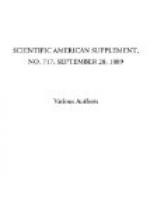“I do most sincerely regret that I cannot be with you in the flesh. I am, like Ixion of old, confined to a wheel (chair in my case), cannot walk, cannot even stand; hence, owing to the impairment of my understanding (???), I must wish you all the enjoyments of the evening, and gladly content myself that you have made so much possible.
“Very truly yours, MOSES G. FARMER.”
* * * * *
THE MODERN THEORY OF LIGHT.[1]
[Footnote 1: Being the general substance of a lecture to the Ashmolean Society in the University of Oxford, on Monday, June 3, 1889. [Reprinted from the Liverpool University College Magazine.]]
By Prof. OLIVER LODGE.
To persons occupied in other branches of learning, and not directly engaged in the study of physical science, some rumor must probably have traveled of the stir and activity manifest at the present time among the votaries of that department of knowledge.
It may serve a useful purpose if I try and explain to outsiders what this stir is mainly about, and why it exists. There is a proximate and there is an ultimate cause. The proximate cause is certain experiments exhibiting in a marked and easily recognizable way the already theoretically predicted connection between electricity and light. The ultimate cause is that we begin to feel inklings and foretastes of theories, wider than that of gravitation, more fundamental than any theories which have yet been advanced; theories which if successfully worked out will carry the banner of physical science far into the dark continent of metaphysics, and will illuminate with a clear philosophy much that is at present only dimly guessed. More explicitly, we begin to perceive chinks of insight into the natures of electricity, of ether, of elasticity, and even of matter itself. We begin to have a kinetic theory of the physical universe.
We are living, not in a Newtonian, but at the beginning of a perhaps still greater Thomsonian era. Greater, not because any one man is probably greater than Newton,[2] but because of the stupendousness of the problems now waiting to be solved. There are a dozen men of great magnitude, either now living or but recently deceased, to whom what we now know toward these generalizations is in some measure due, and the epoch of complete development may hardly be seen by those now alive. It is proverbially rash to attempt prediction, but it seems to me that it may well take a period of fifty years for these great strides to be fully accomplished. If it does, and if progress goes on at anything like its present rate, the aspect of physical science bequeathed to the latter half of the twentieth century will indeed excite admiration, and when the populace are sufficiently educated to appreciate it, will form a worthy theme for poetry, for oratorios, and for great works of art.




